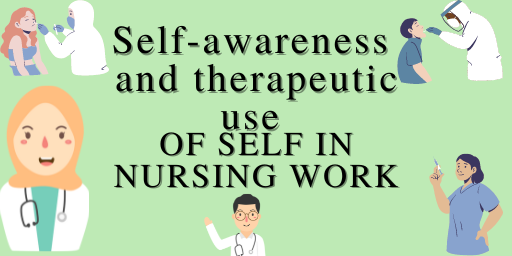Therapeutic Use of Self Awareness

Self-awareness and therapeutic use of the self in nursing is a part of psychiatric nursing and how to offer self for therapeutic purposes.
Self-awareness
Before he can begin to understand clients, the caregiver
must first get to know himself. Self-awareness is the process of developing an
understanding of one's own values, beliefs, thoughts, feelings, attitudes,
motivations, biases, strengths, and limitations and how these qualities affect
others. It allows the caregiver to observe, pay attention and understand the
subtle reactions of the clients when they interact with them. and reactions
Values are abstract standards that give a person a
sense of right and wrong and establish a code of conduct for television.
Examples of values are hard work, honesty, sincerity, cleanliness and order.
The values clarification process is useful for gaining insight into oneself
and one's personal values.
The value clarification process consists of three steps:
selection, pricing, and action. Choosing is when the person considers a range
of possibilities and freely chooses the value that seems correct. Bestowing is
when the person looks at the value, appreciates it and attributes it publicly.
Action is when the person puts value into action. For example, a clean and tidy
student was assigned to live with another student who left clothes and food all
over her room. The initially ordered student is not sure why she is reluctant
to return to the room and feels tense in the presence of her roommate.
Examining the situation, she realizes that they view the use of personal space
differently (selection). Later, she discusses her conflict and decisions with
her advisor and friends (award ceremony). Finally, she decides to negotiate an
engagement with her roommate (acting).
Beliefs are ideas that you believe to be true, such as
"All old people are hard of hearing," "When the sun shines, it
will be a good day," or "Pea plants should be planted on St.
Patrick's Day." Some beliefs have objective evidence to support
them. For example, people who believe in evolution have accepted the evidence
supporting this explanation of the origin of life. Other beliefs are irrational
and may persist even though those beliefs do not support evidence or are
empirically contradictory. evidence exists For example, many people have
irrational beliefs about cultures other than their own, which they have
developed simply from the comments of others or fear of the unknown, not from
any evidence to support such beliefs.
Attitudes are general feelings or a frame of reference
around which a person organizes his or her knowledge of the world. Attitudes
such as hopeful, optimistic, pessimistic, positive and negative shape our view
of the world and of people. A positive mental attitude occurs when a person
chooses to put a positive spin on an experience, comment, or judgment. For
example, in a crowded line, the person in front pays the change and slowly
counts it out. The positive person in line would appreciate the extra minutes
and use them for breathing and relaxation exercises. A negative attitude also
affects the way you see the world and other people. For example, a person who
has had an unpleasant experience with a rude waiter may develop a negative
attitude toward all servers. Such a negative attitude can lead the person to
behave rudely and unpleasantly with every waiter they meet.
The caregiver must periodically reassess and adjust her
beliefs and attitudes as she gains experience and wisdom. Constant
self-knowledge allows the caregiver to accept the values, attitudes and beliefs
of others, which may differ from their own. A person who fails to assess
personal attitudes and beliefs may have a prejudice or bias against a group of
people because of preconceived notions or stereotypical images of that group.
It is not uncommon for a person to be ethnocentric (believing their own culture
is superior to others') about their own culture, especially if the person has
no experience of a culture other than their own.
Therapeutic use of self
By developing self-awareness and beginning to understand
their attitudes, the caregiver can begin to use aspects of their personality,
experiences, values, feelings, intelligence, needs, coping skills, and perceptions
to build relationships with clients. This is called the therapeutic use of
self. Nurses use themselves as a therapeutic tool to build therapeutic
relationships with clients and to help clients grow, change, and heal.
Describing this therapeutic use of the self in the nurse-client relationship,
Peplau (1952) believed that nurses must understand themselves clearly in order
to foster their clients' growth and not limit clients' choices to those they
support to appreciate.
The personal actions of the caregiver arise from conscious
and unconscious responses shaped by life experiences and educational, spiritual
and cultural values. Caregivers (and all people) tend to use many automatic
responses or behaviors simply because they are familiar with them. You need to
examine these accepted responses or behaviors and assess how they support or
hinder the therapeutic relationship. A useful tool for learning more about
yourself is the Johari Window (Luft, 1970), which creates a "word
portrait" of a person in four areas, showing how well that person knows
themselves. The four areas assessed are as follows:
Quadrant 1: Overt/public qualities of self that one knows
about oneself and that others also know.
Quadrant 2: Blind/unconscious qualities of self known only
to others.
Quadrant 3: Hidden/private personal qualities known only to
oneself.
Quadrant 4: Unknown: An empty quadrant symbolizing qualities
not yet discovered by oneself or others.
In creating a Johari Window, the first step for the
caregiver is to assess their own qualities by making a list of them: Values,
Attitudes, Feelings, Strengths, Behaviors, Achievements, Needs, Desires, and
Thoughts. The second step is to find out the perceptions of others by
interviewing them and asking them to identify the positive and negative
qualities they see in the caregiver. To learn from this exercise, the opinions
expressed must be honest; No sanctions should be imposed on those who list
negative qualities. The third step is to compare lists and assign properties to
the appropriate quadrant.
If quadrant 1 is the longest list, this indicates that the
caregiver is open to others; a smaller Quadrant 1 means that the caregiver
shares little about herself with others. If quadrants 1 and 3 are small, the
person shows little insight. Any change in one quadrant is reflected by changes
in other quadrants. The goal is to work on moving qualities from quadrants 2,
3, and 4 to quadrant 1 (qualities known to self and others).
knowledge pattern
Nursing theorist Hildegard Peplau (1952) identified
prejudice, or the way one person expects another to behave or speak, as a
barrier to authentic relationship formation. Prejudice often prevents people
from getting to know each other. Prejudices and different or conflicting
personal beliefs and values can prevent the nurse from establishing a
therapeutic relationship with a client. Here is an example of prejudice disrupting
a therapeutic relationship: Mr. Lopez, a client, has a preconceived stereotype
that all caregivers are gay and refuses to let Samuel, a caregiver, care for
him. Samuel has a preconceived stereotype that all Hispanic men use
switchblades, so he is relieved that Mr. Lopez refused to work with him. Both
men miss out on an opportunity to do important work together due to false
preconceptions.
Carper (1978) identified four patterns of knowledge in
nursing: empirical knowledge (derived from nursing science), personal knowledge
(derived from life experiences), ethical knowledge (derived from moral
knowledge about nursing), and aesthetic knowledge (derived from the art of
nursing). of nursing). . These patterns provide the caregiver with a clear
method of observing and understanding each client's interaction. Understanding
where knowledge comes from and how it influences behavior helps the nurse
become more confident. Munhall (1993) added another pattern, which
she called ignorance: when the nurse admits that she does not know the client
or the client's subjective world, this opens the way for a truly authentic
encounter. The nurse in a state of ignorance is open to seeing and listening to
the client's points of view without imposing her values or points of view on
him. In psychiatric nursing, negative biases on the part of the nurse can
negatively affect the therapeutic relationship; Therefore, it is particularly
important that the nurse works to develop this openness and acceptance towards
the client.




Give your opinion if have any.